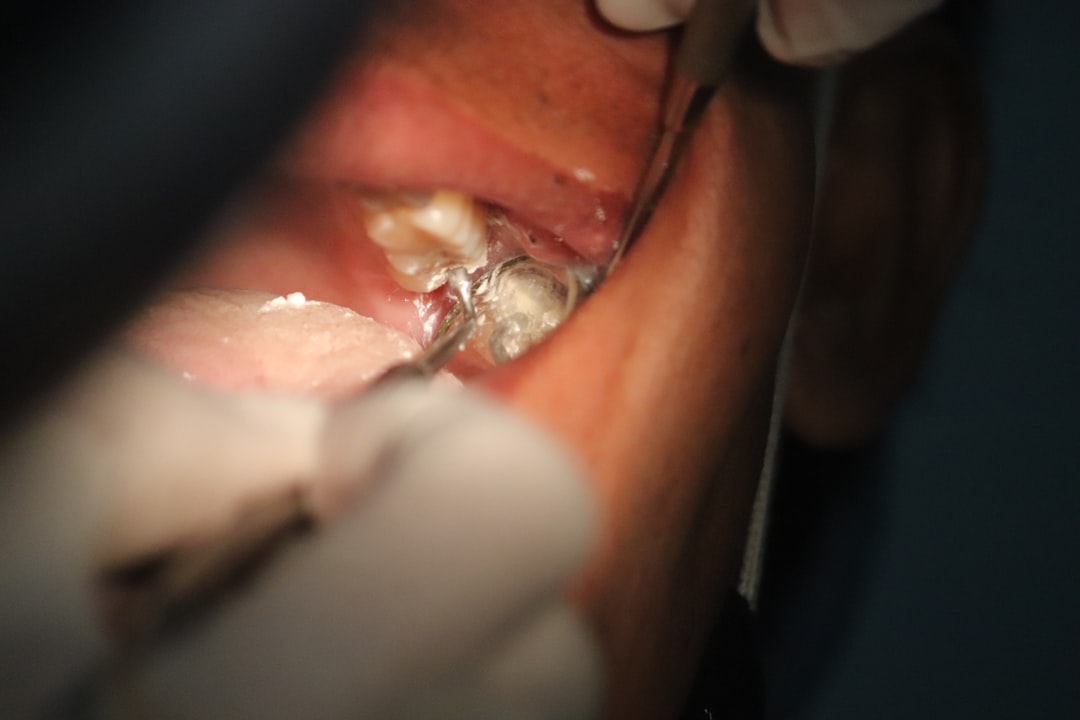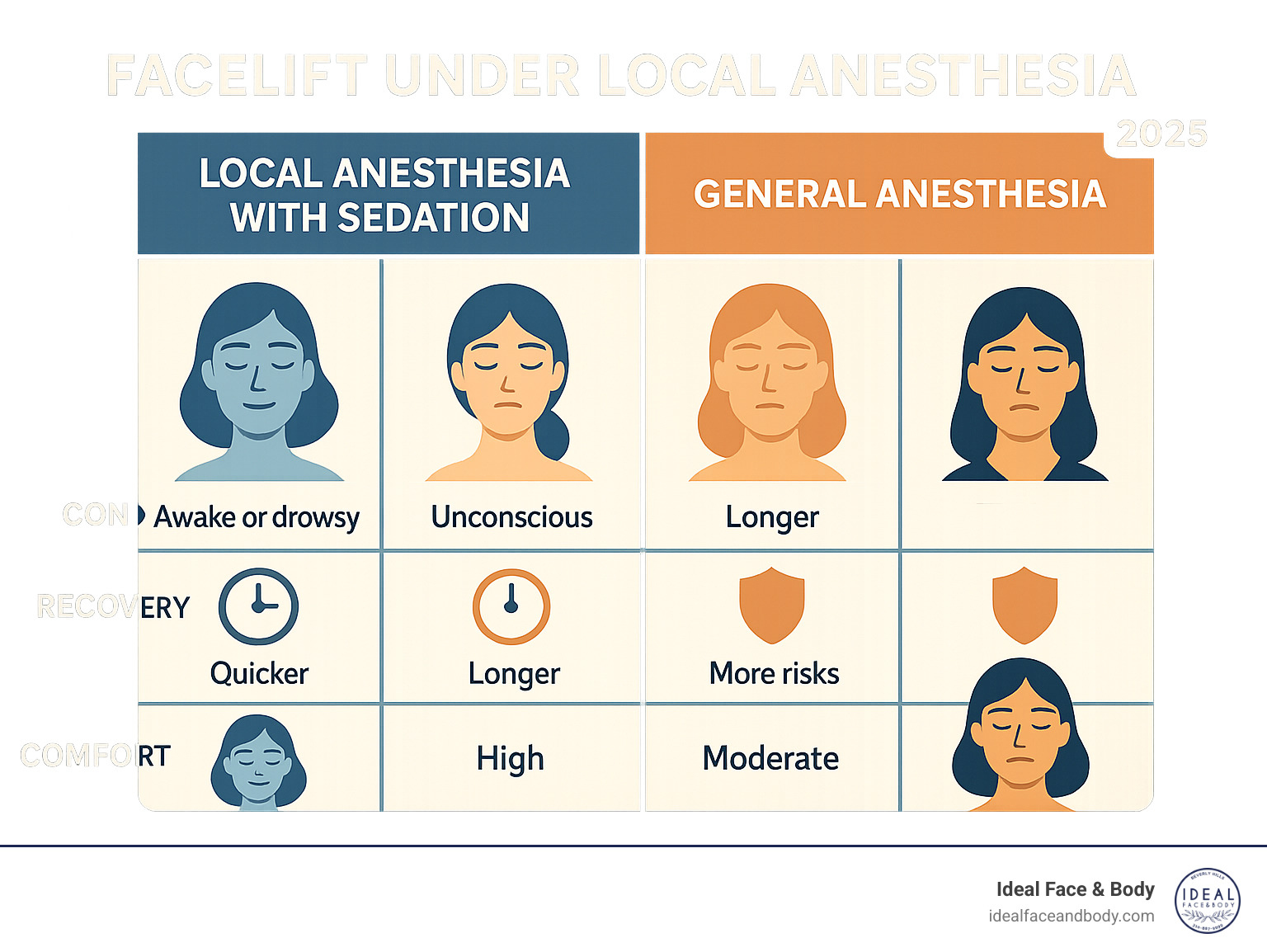Facelift under local anesthesia: The #1 Safe
Why Consider a Facelift Under Local Anesthesia?
A facelift under local anesthesia is a approach that allows you to achieve stunning facial rejuvenation without the significant risks and prolonged recovery associated with general anesthesia. This modern technique masterfully combines targeted local numbing agents with light intravenous sedation, ensuring you remain comfortable, calm, and pain-free throughout the entire procedure.
Quick Answer: Can you get a facelift with local anesthesia?
- Yes – Both mini and full facelifts can be effectively and safely performed under local anesthesia with sedation.
- Safety – This method eliminates the cardiovascular and respiratory risks of general anesthesia while maintaining surgical precision and effectiveness.
- Recovery – Patients experience a significantly faster healing process with less bruising, swelling, and a near-total absence of post-operative nausea.
- Comfort – Twilight sedation keeps you in a deeply relaxed, dream-like state, and most patients have little to no memory of the procedure itself.
- Results – The aesthetic outcomes are identical and just as long-lasting compared to traditional facelift methods that use general anesthesia.
Many people dream of turning back the clock on facial aging but feel understandably anxious about “going under” for surgery. The fear of general anesthesia is a major barrier for many potential patients—and for good reason. Traditional surgical approaches often involve breathing tubes, muscle paralytics, a higher risk of postoperative nausea and vomiting (PONV), and that dreaded, multi-day “anesthesia hangover” that leaves you feeling groggy and unwell.
But here’s the exciting news: you don’t need to endure general anesthesia to achieve excellent, lasting facelift results.
Modern facelift techniques that use local anesthesia with sedation offer a safer, more neat, and comfortable alternative. You’ll be technically awake but deeply relaxed, often drifting in and out of a light, pleasant sleep. Most patients are genuinely amazed at how comfortable and stress-free the experience is, and the amnesic effect of the sedation means many don’t even remember the surgery afterward.
As Dr. Sarah Yovino, I have dedicated my practice to perfecting advanced techniques that prioritize patient safety and comfort while delivering exceptional, natural-looking results. This includes specialized approaches for facelift under local anesthesia procedures. My extensive training in advanced pain management protocols allows me to create a virtually painless experience that puts even the most anxious patients at ease throughout their rejuvenation journey.
Simple facelift under local anesthesia word guide:
What is an Awake Facelift? Understanding the Anesthesia
An awake facelift is a term for a facelift performed without general anesthesia. Instead, it uses a sophisticated combination of local anesthesia (tumescent fluid with lidocaine) and light IV “twilight” sedation. This dual approach ensures that your face is completely numb while you remain profoundly relaxed and comfortable. Crucially, you continue to breathe on your own throughout the procedure, eliminating the need for a breathing tube and the risks associated with deep, medically induced unconsciousness.
| Local Anesthesia + Sedation (Awake Facelift) | General Anesthesia (Traditional Facelift) | |
|---|---|---|
| Awareness | Conscious but deeply relaxed and drowsy | Fully unconscious and unresponsive |
| Breathing tube | Not needed; you breathe naturally | Required to manage breathing |
| Nausea/grogginess | Minimal to none | Common and can be severe |
| Recovery from drugs | Rapid; clear-headed within hours | Slow; can take hours to days to resolve |
| Safety profile | Avoids GA risks, excellent safety record | Very safe but carries higher overall risk |
The Science Behind Local Numbing
We use a technique involving tumescent fluid, which is a saline solution containing diluted lidocaine and epinephrine, gently infused into the treatment area. Lidocaine is a local anesthetic that works by temporarily blocking nerve signals, preventing any sensation of pain from reaching your brain. The small amount of epinephrine is a vasoconstrictor, meaning it narrows the blood vessels. This has a powerful dual benefit: it dramatically reduces bleeding during surgery, which in turn leads to less post-operative bruising and swelling. It also keeps the lidocaine localized to the surgical area for a longer period, enhancing its numbing effect and overall safety. A study in the Aesthetic Surgery Journal confirms this method removes general-anesthesia risks without adding new complications. Read the study.
What Is “Twilight Sedation”?
Twilight sedation, or conscious sedation, involves administering medication through an IV to induce a state of extreme relaxation. You are not unconscious, but in a calm, dream-like state. Many patients describe it as the best nap of their life. You may drift in and out of a light sleep and will be able to respond to simple questions from the surgical team if needed, but you will be unconcerned by the process. A key benefit is the amnesic effect of these medications; most patients remember little to nothing about the procedure afterward. Because the drugs are short-acting and leave your system quickly, you avoid the prolonged grogginess and nausea—the “anesthesia hangover”—that is so common with general anesthesia.
The Key Benefits of Opting for Local Anesthesia
The advantages of choosing an awake facelift extend beyond simply avoiding general anesthesia. The entire experience, from the procedure itself to the recovery period, is often smoother and more comfortable.
- Improved Safety Profile: This is the most significant benefit. By avoiding general anesthesia, you eliminate risks such as adverse reactions to anesthetic agents, respiratory depression requiring a ventilator, blood clots (deep vein thrombosis), and postoperative cognitive dysfunction, which can be a concern for older patients.
- Faster, More Comfortable Recovery: With no lingering anesthetic drugs in your system, you bypass the common post-surgical phase of nausea, vomiting, and grogginess. This allows you to hydrate and eat sooner, which kickstarts the healing process. Most patients feel clear-headed and alert just hours after the procedure.
- Less Bruising and Swelling: The epinephrine used in the local anesthetic solution is highly effective at constricting blood vessels. This minimizes bleeding during the surgery, resulting in significantly less bruising and swelling afterward. Less trauma to the tissues means a quicker resolution of these side effects.
- Quicker Return to Daily Life: The combination of a faster recovery from anesthesia and reduced side effects means you can get back to your routine more quickly. Many patients feel comfortable returning to a desk job and light activities within a week.
- Potentially Lower Overall Cost: Since an awake facelift can often be performed safely in an accredited in-office surgical suite rather than a hospital, it may eliminate the need for separate, costly hospital operating room fees and the fee for an anesthesiologist’s services for the entire duration.
Cosmetic Benefits of a Facelift
Are There Any Limitations?
While the awake facelift is an excellent option for a vast majority of patients, there are some considerations. A small number of individuals have a strong psychological preference for being completely unconscious during any surgical procedure. Additionally, extremely long or complex procedures that combine multiple major surgeries might push the limits of patient comfort under local anesthesia. This is why the initial consultation is so critical. A skilled surgeon will assess not only your physical candidacy but also your psychological comfort level to ensure this approach is the perfect fit for you.
The Awake Facelift Procedure: A Step-by-Step Guide
Understanding the process can help explain the experience and ease any remaining concerns. Here is what you can typically expect:
- In-Depth Consultation: Your journey begins with a thorough discussion with your surgeon. This involves a detailed review of your medical history, an examination of your facial anatomy and skin quality, and a conversation about your aesthetic goals. We will determine your candidacy for the awake procedure and map out a personalized surgical plan.
- Pre-Operative Preparation: You’ll receive a clear set of instructions to follow before your surgery. This may include temporarily stopping certain medications or supplements (like blood thinners), guidelines for eating and drinking before the procedure, and advice on skincare.
- Arrival and Numbing: On the day of your surgery, you’ll arrive at our comfortable, accredited facility. You may be given an oral medication to help you begin to relax. Then, the surgeon will carefully and gently administer the local anesthetic injections to completely numb the treatment areas.
- Sedation and Monitoring: Once you are settled, light IV sedation will be started. This is not general anesthesia; it is designed to put you into a deeply relaxed, “twilight” state. Your vital signs, including heart rate, blood pressure, and oxygen levels, will be continuously monitored by our expert team throughout the entire procedure to ensure your utmost safety.
- The Surgical Procedure: With you resting comfortably, Dr. Sarah or Dr. Justin Yovino will perform the facelift. This involves making discreet incisions, typically hidden within the hairline and the natural contours around the ear. The key to a modern, long-lasting facelift is lifting and tightening the underlying SMAS layer (Superficial Musculoaponeurotic System). This is the structural support network of the face, and addressing it is what provides a true lift, avoiding a tight, “pulled” look. After repositioning the deep tissues, excess skin is carefully removed, and the incisions are closed with fine sutures.
- Recovery and Discharge: After the surgery is complete, you’ll rest for a short period before being discharged. You will need a friend or family member to drive you home. Most patients are surprised by how alert and clear-headed they feel just a few hours later.
What Do Patients Feel?
You will not feel any sharp pain. The area is completely numb. Patients typically report feeling occasional, gentle pressure or pulling sensations, but the twilight sedation ensures you remain calm and unbothered. Many patients nap peacefully through most of the procedure and, due to the amnesic effects of the sedation, have very little memory of the surgery itself.
Procedures Suited to Local Anesthesia
This versatile approach is ideal for a wide range of facial rejuvenation procedures, either alone or in combination:
- Mini facelift
- Lower facelift (for jowls and marionette lines)
- Neck lift (to address neck bands and excess skin)
- Full facelift for suitable candidates
- Eyelid surgery (blepharoplasty)
- Brow lift
- Facial fat transfer
- Buccal fat removal
- Chin augmentation
Recovery and Results: What to Expect After Your Facelift Under Local Anesthesia
Recovery from an awake facelift is notably quicker and more pleasant than from a traditional one, primarily because you don’t have to overcome the effects of general anesthesia.
- First 24 Hours: You will experience some mild drowsiness from the sedation, but you will be alert enough to walk, eat a light meal, and rest comfortably at home. Your face will be bandaged, and you should focus on resting with your head liftd to minimize swelling.
- Days 2-7 (The First Week): This is when swelling and bruising typically peak and then begin to subside. Discomfort is usually minimal and feels more like tightness, easily managed with prescribed or over-the-counter pain medication. Continuing to use cold compresses and keeping your head liftd are crucial during this time. You will have a follow-up appointment where your surgeon will check your healing progress, and sutures are often removed around the one-week mark.
- Week 2: A significant amount of swelling and bruising will have resolved. Most patients feel comfortable and confident enough to return to work (if non-strenuous) and resume light social activities. You can typically start wearing makeup to camouflage any remaining discoloration.
- Weeks 2-4: You can gradually reintroduce most forms of exercise. While you will look and feel great, some subtle swelling may persist for several weeks or even months, which is a normal part of the healing process as your tissues settle.
Because you skip the deep anesthesia “hangover,” you are able to get up and move around sooner. This gentle, early ambulation helps boost circulation, which can further accelerate healing and reduce the risk of complications.
Are the Results Just as Good?
Absolutely. The quality and longevity of a facelift result—which is often 10-15 years—are determined by the surgeon’s technique, not the type of anesthesia used. A skillful SMAS lift, which repositions the deeper facial structures, is what creates a natural, refreshed, and long-lasting outcome. The anesthesia method is simply the tool used to ensure your comfort and safety during that procedure. The final aesthetic result of a well-performed awake facelift is indistinguishable from one performed under general anesthesia. See stunning examples in our gallery: Face and Neck Lift Gallery.
Frequently Asked Questions about the Awake Facelift
Who is an ideal candidate for an awake facelift?
Ideal candidates are generally healthy individuals, typically non-smokers, who are experiencing mild-to-moderate signs of facial aging like jowling, sagging cheeks, and deep creases. It is an especially excellent choice for anyone who feels anxious about general anesthesia or has underlying medical conditions that make general anesthesia a higher risk.
Is the procedure painful?
No. Patients do not feel pain during the surgery. You may feel a brief pinch or sting from the initial numbing injections, similar to dental work. After that, the area is completely numb. The twilight sedation ensures you are relaxed and unconcerned with any sensations of pressure or movement. Post-operative discomfort is typically mild, described as a feeling of tightness, and is well-managed with standard pain relievers.
How long does the surgery take?
The duration of an awake facelift varies depending on the extent of the procedure. A mini facelift might take around 2-3 hours, while a more comprehensive full facelift and neck lift could take 4-5 hours. Your surgeon will give you a more precise time estimate during your consultation.
Will I have noticeable scars?
Our surgeons are experts at concealing incisions. They are carefully placed within the natural creases in front of and behind the ear, as well as hidden within the hairline. Initially, the scars will be pink, but they fade significantly over time, becoming very difficult to detect once fully healed.
How do I pick the right surgeon?
Choosing your surgeon is the most important decision. Look for a board-certified plastic surgeon or facial plastic surgeon with extensive, specific experience in performing facelifts under local anesthesia. They should operate in a fully accredited surgical facility. Always review their portfolio of before-and-after photos, paying attention to results for patients with similar concerns to yours, and read patient testimonials. Find an Awake Facelift Near Me
Begin Your Rejuvenation Journey in Beverly Hills
Modern surgical advancements mean you no longer have to choose between your desired results and your peace of mind. You can look years younger without the risks and recovery time associated with general anesthesia. At Ideal Face & Body in Beverly Hills, Dr. Sarah Yovino and Dr. Justin Yovino are renowned specialists in delivering beautiful, natural, and lasting results with the sophisticated facelift under local anesthesia approach.
If you are ready to learn how this comfortable and safe procedure can help you achieve your goals, we invite you to take the next step. Schedule your personalized facelift consultation today and begin your journey toward a refreshed, revitalized, and confident you.










